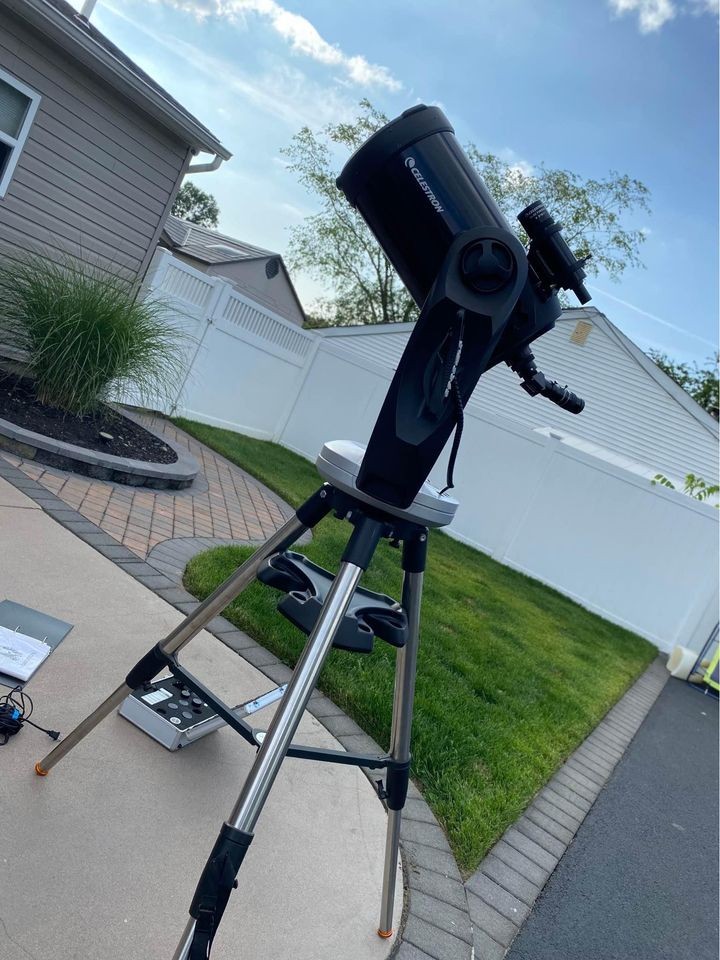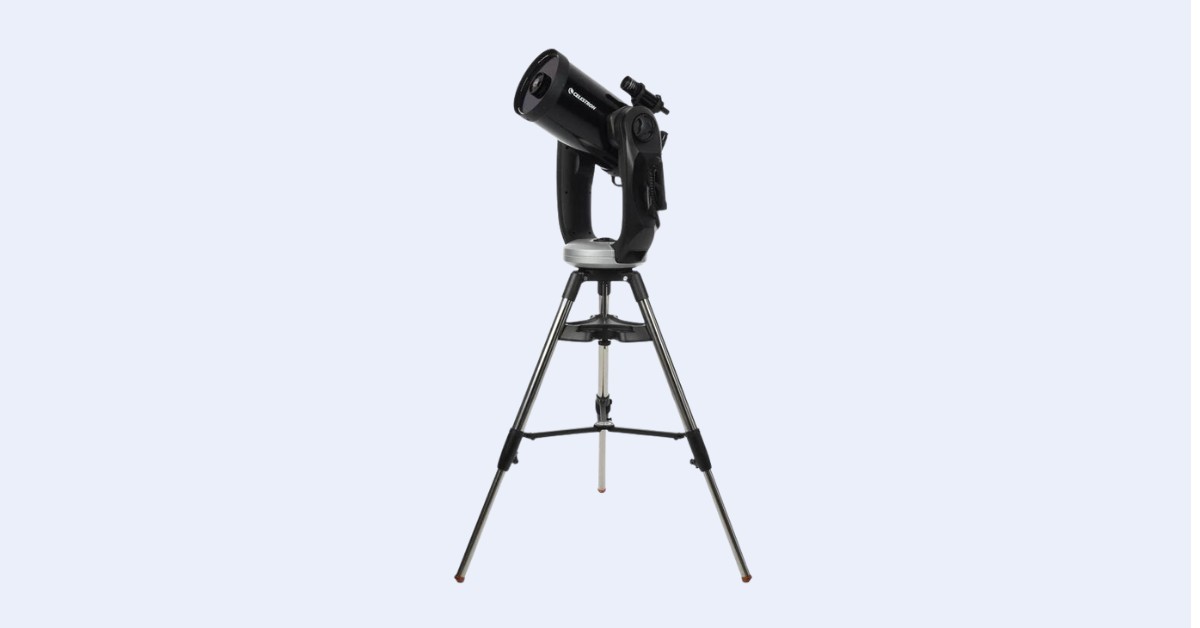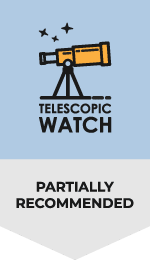The C9.25 XLT Optical Tube
Celestron’s C9.25 XLT optical tube is a 9.25″ (235mm) f/10 Schmidt-Cassegrain telescope with a focal length of 2350mm. The C9.25 XLT stands apart from older C9.25 models by being Starizona HyperStar compatible and boasting slightly enhanced coatings that increase light transmission on the mirrors and front corrector plate.

Launched in the 1990s, the C9.25 is one of Celestron’s more recent Schmidt-Cassegrain telescopes to debut. The Schmidt-Cassegrain design combines a concave spherical primary mirror, a convex spherical secondary mirror, and a Schmidt corrector plate to create sharp images with a long focal ratio (typically f/10) in a compact tube assembly. The C9.25 design utilises a slower primary mirror (f/2.5 vs. f/2) compared to other Celestron Schmidt-Cassegrains, resulting in a slightly longer tube in proportion. Additionally, the secondary mirror’s curvature is less pronounced, meaning that the focal length is multiplied by 4x instead of the usual 5x.
The gentler curvatures of both mirrors in the C9.25 simplify their manufacturing process to a high tolerance, diminish the secondary mirror’s magnification of optical issues with the primary mirror, and offer more forgiving collimation tolerances. As a result, the C9.25 typically provides better images than one might expect for a telescope of its size, particularly for a Schmidt-Cassegrain telescope, which is often known to provide worse-than-average images for a given aperture compared to other optical designs.
As with most Schmidt-Cassegrains, the C9.25 XLT is focused by turning a knob at the back of the telescope, which moves the primary mirror within the tube. This movement can cause some “image shift” when focusing, particularly at high magnifications or during imaging, where the target object appears to shift around the field of view. However, for most C9.25s, this issue is minimal. The bigger issue is “mirror flop” ruining long exposures, a problem solved by the mirror locks built into the EdgeHD version of the C9.25 telescope.
From time to time, the C9.25 XLT may require collimation by adjusting the secondary mirror. We advise against replacing the stock Philips head screws with thumb screws, as they might not be rigid and tight enough to maintain collimation, and they can be too tempting to adjust when the collimation is already adequate. Collimating SCTs is not particularly difficult or time-consuming; you can learn more about it in our collimation guide.
The rear of the C9.25 XLT features a standard threaded port designed to accommodate Schmidt-Cassegrain adapters and accessories. It can fully illuminate the field of a “full frame” camera sensor or 2″ eyepiece without any issues, a feat that the smaller C8 and C6 XLT telescopes cannot achieve. You can also use an f/6.3 focal reducer for deep-sky astrophotography or visual work. However, the former necessitates a more robust mount than the CPC, and the latter serves as an alternative to a 2″ diagonal, which we would recommend instead. By removing the secondary mirror and installing a Starizona HyperStar f/2 conversion kit, the C9.25 XLT can even be transformed into a 470mm focal length Schmidt camera.
Accessories
The CPC 925 GPS includes only a basic set of accessories. Celestron provides a 9×50 finderscope, a 1.25″ visual back, a 1.25″ prism star diagonal, and a 1.25″, 40mm Plossl eyepiece (which yields 59x magnification with the CPC 925). The supplied visual back and star diagonal are adequate, but a 2″ star diagonal or an f/6.3 reducer will enable you to achieve a much broader field of view than is possible with only 1.25″ eyepieces at f/10.
The included E-Lux 1.25″ 40mm Plossl eyepiece is satisfactory, but its 1.25″ barrel diameter results in it only being able to achieve a 40° apparent field of view. This limited view can feel like peering through a narrow tube and offers a true field of view of just 0.6°, slightly larger than the full moon’s apparent diameter in the sky. A 2″ eyepiece or using the f/6.3 reducer would allow you to obtain a field of up to about 1 degree, which is considerably more useful when observing larger deep-sky objects.
As for the finder, the CPC 925 GPS comes with a 9×50 straight-through unit that slides onto the optical tube on a non-standardized bracket. This finder offers a roughly 6° field of view (albeit upside down) with crosshairs and displays stars or even bright deep-sky objects several magnitudes fainter than what is visible with the naked eye—an arguably excessive feature for a GoTo telescope, but a welcome addition nonetheless.
The CPC Fork Mount
The GoTo alt-azimuth fork mount of the CPC 925 is equipped with adjustable clutches for manual aiming when the scope is not powered on, as well as an automatic internal clock and GPS system that update location, date, and time. The C9.25 XLT optical tube can technically be detached from the CPC forks and connected to a dovetail bar for use on an equatorial mount. However, this “de-forking” process is time-consuming and difficult to reverse, making the scope effectively permanently attached for the most part.
Assembling the CPC involves a simple and straightforward process of extending and leveling the tripod, connecting the spreader tray, and positioning the scope on top. This requires less assembly compared to an equatorial mount. However, the C9.25 XLT optical tube and CPC forks together weigh approximately 57 lbs and must be precisely centered on a small center pin when they are lowered onto the tripod. This can be quite cumbersome and potentially hard on your back. An equatorial mount, on the other hand, allows for disassembly into smaller, more manageable pieces. The weight and bulk of the CPC design are the trade-offs for a simpler assembly process.
The CPC fork mount’s NexStar+ hand controller automatically acquires date, time, and location data from the integrated GPS sensor, guiding you through a relatively straightforward alignment process that involves centering at least 2 bright stars. Once aligned, the telescope can target and track any of the 40,000 objects in its database. Additional Celestron accessories like the StarSense AutoAlign system or SkyPortal WiFi adapter can be added to the mount, further streamlining the setup and user experience.
While it is possible to convert the CPC 925 into an equatorial configuration for deep-sky astrophotography using an equatorial wedge, it doesn’t offer the same level of performance as a dedicated equatorial mount. Positioning the scope on the wedge is even more cumbersome than standard assembly, and achieving precise polar alignment is notably more challenging compared to a German equatorial mount. Nevertheless, features like the all-metal worm gearing and autoguider port allow for satisfactory deep-sky imaging if you opt for this setup.
Should I buy a Used Celestron CPC 925 GPS?
A pre-owned CPC 925 GPS can be a superb telescope. However, given the intricate SCT optics and the fork mount’s electronics, there are some potential concerns. A damaged or missing corrector plate is a deal-breaker, as replacing it would cost more than a new C9.25 XLT optical tube. Additionally, it is important to ensure that the entire mount powers up, slews, and tracks properly before purchasing. A malfunctioning GPS unit in the CPC fork mount can be disregarded and won’t actually stop you from using the scope, while a missing hand controller or accessories can be replaced at a relatively low cost.
Alternative Recommendations
For those with a keen interest in deep-sky astrophotography, it is typically advised to opt for a telescope mounted on a German equatorial mount in a modular configuration, rather than a fork-mounted Schmidt-Cassegrain like the CPC 925. Although some astrophotography telescopes include equatorial mounts, it’s often more advantageous to purchase the mount separately. The majority of top-tier astrophotography telescopes are sold without mounts, making it essential to conduct thorough research before buying.
For more information on selecting the right GoTo equatorial mount for imaging, you can consult our Mount Rankings page. Besides the Celestron line of Schmidt-Cassegrain and EdgeHD optical tubes, there is an array of apochromatic refractors and imaging Newtonians available for deep-sky astrophotography. Many beginners prefer one of these options instead of an SCT or EdgeHD scope due to their user-friendliness. Our OTA Rankings page offers additional details on choosing the appropriate optical tube assembly for your astrophotography requirements.
While we typically categorize our alternative recommendations by price range, the CPC 925 has such a diverse selection within its price bracket that we’ve compiled a brief list of some telescopes you might want to consider for visual observation and planetary imaging purposes instead.
- The Celestron Advanced VX 9.25” Schmidt-Cassegrain delivers the same views and GoTo capabilities as the CPC 925 but disassembles into more manageable components. The Advanced VX mount is also fairly competent for deep-sky astrophotography when paired with a smaller telescope optical tube and appropriate addons.
- The Celestron CGEM II 1100 and CPC 1100 provide larger apertures than the CPC 925, although they are considerably heavier, bulkier, and have a limited field of view. The CPC 1100 exacerbates the issue of the combined tube/fork mount’s weight and the challenge of positioning it on a tripod.
- Sky-Watcher offers Flextube GoTo Collapsible Dobsonians in 8″, 10″, 12″, 14″, and 16″ apertures, with the smaller three also obtainable in more budget-friendly manual-only formats. These telescopes feature compact designs and GoTo functionality with Sky-Watcher FreedomFind encoders, allowing manual aiming without impacting GoTo precision or tracking. The FlexTube design enhances portability compared to a solid-tubed Dobsonian while maintaining setup ease relative to a full truss.
- The Apertura AD/Zhumell Z/Orion SkyLine Dobsonians are available in 8″, 10″, and 12″ apertures, offering exceptional value and delivering outstanding views through the eyepiece. They come with robust mounts, practical accessories, and features at an unbeatable price.
- Celestron’s StarSense Explorer Dobsonians are accessible in 8″ and 10″ apertures and feature optimized, lightweight mount designs and Celestron’s StarSense Explorer technology, which assists users in navigating the night sky using their smartphones. However, they do not include many accessories or additional features, despite their higher price tags compared to most other Dobsonians.
Aftermarket Accessory Recommendations
If you possess a CPC 925 GPS or any other catadioptric telescope, it is strongly advised to invest in a dew shield to prevent moisture accumulation on the front corrector plate during humid nights. This is crucial not only for maintaining image quality but also for protecting the coatings. A simple plastic or homemade dew shield may be adequate, but heated alternatives are available for those in particularly humid climates. Besides its moisture-prevention benefits, a dew shield can help minimize stray light and enhance contrast at the eyepiece, especially in areas with light pollution or during bright lunar phases.
For visual observations with the 9.25, there is a wide array of eyepieces and accessories to explore. A good 2″, screw-on dielectric star diagonal expands the maximum field of view with the CPC 925, and the Apertura 38mm SWA eyepiece provides the widest possible field of view and is ideal for low-power deep-sky observations. For medium to high magnifications, consider wide-angle eyepieces such as the Baader Hyperions or the Explore Scientific 82-degree series. It is wise to have at least three or four high-quality eyepieces to fully utilize the telescope’s potential, although budget-friendly “goldline” or “redline” eyepieces perform adequately at f/10.
We also suggest using a UHC filter like the Orion UltraBlock to enhance your views of nebulae like the Orion Nebula, as the increased contrast is particularly beneficial in light-polluted locations. Finally, a power supply like the Celestron PowerTank Lithium Pro is necessary for operating the CPC fork mount during extended observing sessions.
What can you see?
The CPC 925 GPS delivers exceptional deep-sky views, as one would expect from a telescope of this caliber and aperture size. Open star clusters such as M35 and M11 look spectacular. However, larger clusters like the Pleiades (M45) and Beehive (M45) are too vast to fit in the EdgeHD 9.25’s limited field of view of no more than 1.1 degrees, which can be disappointing. Globular star clusters such as M15 and M13 reveal individual stars, differences in brightness, size, and shape when viewed at high power, although some may still be out of reach. There are also plenty of colorful double stars you can split with this telescope on a steady night.
Observing galaxies requires dark skies; they appear as faint, washed-out smudges in urban areas with little detail to be seen in any telescope. Nevertheless, the CPC 925 EdgeHD is capable of revealing dust lanes and even spiral arms in several galaxies under optimal conditions, as well as groups of galaxies such as the Leo Triplet and the Virgo Cluster. Emission nebulae such as Orion (M42), the Swan (M17), and the Lagoon (M8) are still visible even under light-polluted skies. They become stunningly detailed under darker skies and with the help of a UHC nebula filter. Moreover, planetary nebulae present a wealth of colors and intricate details when viewed at high power under steady skies with the CPC 925 EdgeHD.
The CPC 925 GPS provides crisp views of Venus and Mercury’s phases, while the Moon unveils a remarkable amount of detail, such as craters, mountain ranges, ridges, and smooth basaltic maria. During the months surrounding opposition, when Mars is nearest to Earth and appears at its largest and brightest, the planet’s polar ice caps and a few dark surface markings can be observed. Jupiter’s vibrant cloud belts, storms, and the Great Red Spot are clearly discernible, as are the disks of all four Galilean moons, along with their shadows during transits in front of Jupiter. Saturn’s rings are spectacular, featuring the razor-thin Cassini Division and a few moons scattered around the planet. On particularly steady nights, the CPC 925 can even reveal the Encke gap within the rings. Uranus’ turquoise disk and a couple of moons can be detected, while Neptune is just barely perceptible, along with its accompanying moon Triton. Finally, under dark skies, Pluto is just within reach of the CPC 925’s light-gathering power, although it can be difficult to find.
Astrophotography Capabilities
For lunar and planetary imaging, the CPC 925 GPS performs admirably, as one would expect from any well-made Schmidt-Cassegrain telescope of this size equipped with motorized tracking. Utilizing a suitable CMOS high-speed planetary camera, like the ZWO ASI224MC, and incorporating a 2x or 3x Barlow lens to increase the scope’s focal ratio to f/20-f/30, can yield impressive results with free image capture and processing software and just a few minutes of footage.
The CPC 925 GPS can be used for long-exposure deep-sky astrophotography with the addition of an aftermarket equatorial wedge and either a Hyperstar f/2 kit or an f/6.3 reducer-corrector. However, there are some edge-of-field aberrations with the non EdgeHD-C9.25 as well as mirror flops, which can affect longer exposures. Furthermore, accurately polar aligning the scope in this configuration can be extremely challenging, and its tracking and guiding quality is inferior to what a high-quality German equatorial mount, such as the Sky-Watcher EQ6Ri Pro or Celestron CGX, can provide when combined with the C9.25 XLT optical tube or the EdgeHD version of the C9.25.



